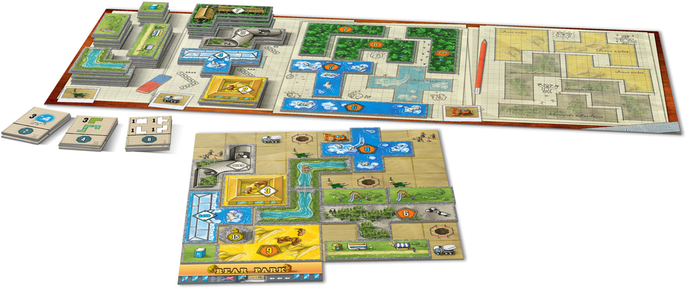
Bärenpark is a lightweight tile-placement game along the lines of Patchwork, both of which take the basic concept of Tetris—take a tile, possibly with a weird shape, and place it on your board, with the goal of filling all the open spaces—and turn it into a multiplayer game. Patchwork is strictly a two-player game and limits your tile choices to the next three tiles available in the central market, while Bärenpark plays up to four (it’s best with four players, really) and gives you a broader choice of tiles without penalizing you for spaces you don’t fill at the end of the game. As a light family game, it works very well, but there’s a hiccup in the rules that would allow someone to get cutthroat and make it a lot less fun or fair for younger players.
Players in Bärenpark start with one 4×4 park board apiece and take tiles from the central supply to try to fill out that board. Some spaces on the park boards are marked with icons that, once covered, give the player the right to take tiles of specific types from that supply. Greenspace tiles are just fillers, occupying one, two or three squares on park boards without awarding any points. Houses for the four bear types (pandas, polar bears koalas, and gobis) in the game range from 7 points down to 1, with the tiles atop each stack worth more; each house type has a unique shape. Enclosures are unique, worth 6 to 8 points each, and are larger with more irregular shapes, so they’re harder to place—and harder to obtain. Each park board also has a construction crew icon, which allows you to take another park board from the supply to expand your personal park, adding up to three new boards; the added boards have excavator icons, which you need to cover to take an enclosure tile. Placing a large tile may cover two or three icons and allow you to take multiple tiles at once. On a turn, you must place a tile if you can; if you don’t have any tiles, you take one greenspace tile as your entire turn.
The biggest bonuses come when you fill 15 of the 16 spaces on any one park board, with the final space, called a pit, reserved for the bear statue you’ll take as a reward for filling your board. In the four-player game, there are 16 bear statues, with point values from 16 down to 1. Any player who finishes a board takes the highest-valued statue still on the table, so there’s a benefit to finishing early—but you may choose to wait to fill a board so that you can cover certain icons and gain higher-valued enclosures or houses instead.
The advanced game brings “achievements” into the scoring, rewarding players for placing multiple tiles of the same type or in specified combinations on their boards. You might gain 8 points for placing one of each of the four bear house types, or for placing three koala house or enclosure tiles. You can gain 9 points for placing three food street greenspace tiles in a row. Each achievement bonus comes with three tiles, with the first player to claim an achievement getting the most points. This changes game strategy substantially, and can help balance out the problem—mentioned below—of the scarcity of greenspace tiles, but also requires players to weigh two different strategic paths at the same time, which might be too much for younger players.
The two smallest greenspace tiles, representing toilets (one square—I doubt that’s a Seinfeld reference but I hope it is) and playgrounds (two squares) are limited to ten apiece, and they tend to be important for players to finish their boards, if not outright essential. The supplies of these tiles are limited and thus the game rewards careful planning—but it’s also possible for players to take these tiles without any intention of using them. As you place tiles near the end of the game, you will still get the right to take further tiles, including these greenspace tiles, even if you won’t or can’t use them. That can give one player the chance to just grab those one- and two-space tiles (toilets and playgrounds) to block other players from finishing, which isn’t something I’d consider appropriate for a family game. The first time this happened, I simply put back tiles it was clear I would never be able to use. Other players have commented in online reviews that they allowed players to use coins for the one-space tiles, treating the supply of toilets as unlimited, which would help younger players but does remove the game’s built-in rewards for players who plan ahead. It’s also possible for all players to reach a point where they can no longer place any pieces, a game-end condition that isn’t covered in the rules.
With a little rules tweak, I think Bärenpark is a great game for three or four players, mixing kids with adults. I would suggest precluding any player from taking a tile s/he can’t place, or requiring players to return tiles they can’t use; the alternative is to treat the one- and two-space tiles as unlimited, which I think ends up dragging down players who did plan around their eventual scarcity in a way that overbalances the game.
Keith Law is a senior baseball writer for ESPN.com and an analyst on ESPN’s Baseball Tonight. You can read his baseball content at search.espn.go.com/keith-law and his personal blog the dish, covering games, literature, and more, at meadowparty.com/blog.
